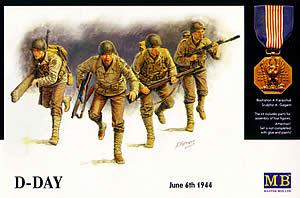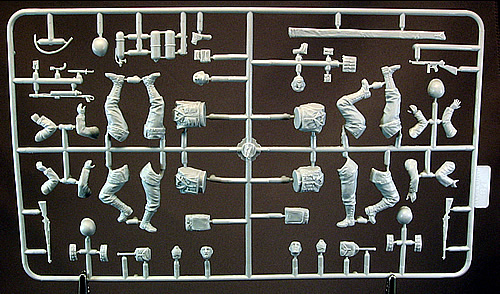|
D-Day
June 6, 1944
|
 |
|
In a very short time, Master Box has gotten a well-deserved reputation for producing some of the more interesting figure sets and creative poses. This is a highly animated quartet charging the beachhead. From the box art, it appears the soldiers are dressed in uniforms typical for not only D-Day, but Operations Torch or Husky, as well. Or, for that matter, a corn field. These figures do not wear the waist life vests, rubberized assault gas mask bags, and gas detection brassards common on D-Day. It's a mixed blessing: The distinctive features that tie the figures so indelibly to one central event also limit the figures' diorama options. DML went both ways in their U.S. 29th Infantry Division (Omaha Beach), giving you a few figures you could drop into a cow pasture or town square. MB opted to make the figures to be more ubiquitous and usable in settings late into the war (swap the bangalore for a Garand). But closer examination of the actual pieces reveals a problem: Only the non-com with the Thompson has the proper jacket design. The jackets on the other three figures, which ostensibly would be M1941 "Parsons" jackets, incorrectly have breast pockets, making the chests look more similar to the M1943 OD jacket—only with buttons down the center. The cuffs on the sleeves and bottem hem of the jacket are common to the Parsons jacket, so these don't represent any type of shirt (a shirt collar is seen under the jacket). One reviewer has suggested these are "battle-jerkins," presumably alluding to the assault vests worn by the Rangers on D-Day (see Dragon's U.S. Rangers Normandy set), but that is incorrect. Unfortunately, this hybrid uniform is a problem shared with the U.S. Machine-Gunners and U.S. Infantry sets. I shared this observation with Alexander at MB, who had been kind enough to send me the review samples. I forwarded some photos to him and he agreed that the jackets were incorrect and vowed that MB would work toward improving their accuracy. But all is not lost. You can take your hobby knife and scrape down these pockets, or smooth them over with a dab of putty. One of the things that impresses me about Master Box is that they take the time to sculpt and mold individual backpacks, unlike the other companies that only provide one generic pack for all the figures. And the backside of the packs are designed to fit snuggly on the backs of each soldier. rather than floating atop the folds of clothing and curve of the spine. Even the two one-piece meat can pouches and M1938 entrenching tools are also different! The ammo pouches for the web belts are molded as one piece per side of the belt, rather than eight or ten individual pouches as done by Dragon. While not quite as crisply defined as indy pouches, they fit the bodies better and are quicker to install. The weapons and M1A1 flamethrower are well done, but the short, holstered handgun identified as part #2 is a bit of a curiousity, not being the standard size .45. As it's worn by the non-com, perhaps it's a flare gun or private purchase? Unfortunately, the canteens are still the cross-strapped Marine Corps versions more suitable for the South Pacific than Northern Europe. Alexander said they will change this to the proper U.S. Army style in future sets. While a bit of a step backwards in terms of accuracy from previous Master Box offerings, the figures are redeemed by their dynamic poses and versatility. And Master Box seems eager to improve its accuracy, and that's a good thing for them and us. Review sample courtesy of Master Box.
-tss- |
 |
 |
 |
 |
 |
 |
 |
 |
 |
 |
 |
 |
|
 Master
Box Ltd.
Master
Box Ltd.